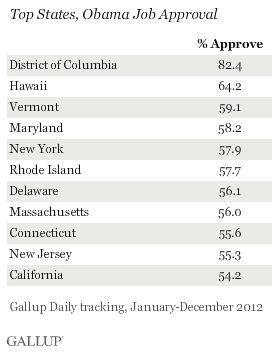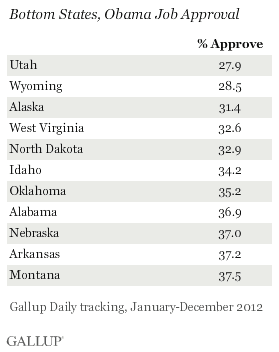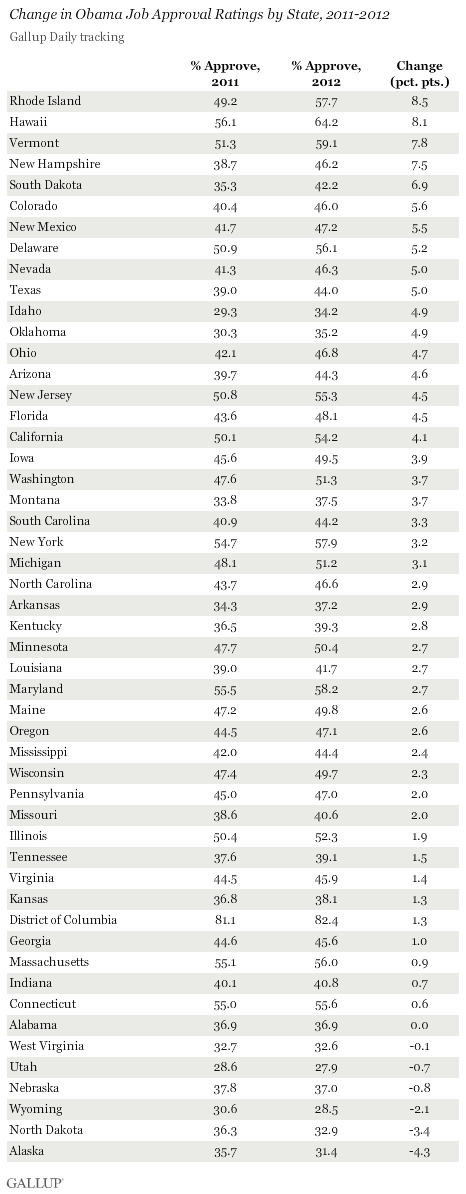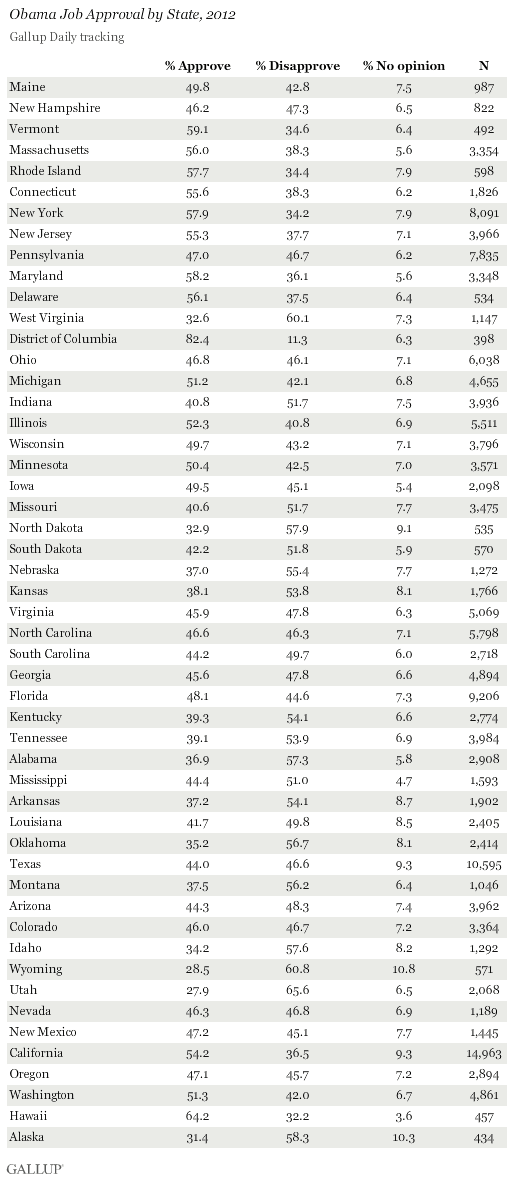PRINCETON, NJ -- Residents of Hawaii, along with those living in the District of Columbia, were most likely to approve of President Barack Obama in 2012, according to an analysis of Gallup Daily tracking for the year. Residents of Utah and Wyoming were least likely to approve, with fewer than three in 10 residents giving Obama a positive review.


The full results by state appear on page 2.
The states with the highest and lowest approval ratings are generally similar from year to year, with some shuffling of the rank ordering. This year, only one of the top 10 states (plus D.C.) is different compared with 2011, with Rhode Island moving into the top 10 and Illinois dropping out. Among the bottom 11 states, Kentucky and South Dakota have dropped out, replaced by Alabama and Nebraska.
All told, Obama received majority approval in 14 states and the District of Columbia. That compares with the 26 states and the District of Columbia he won in the 2012 presidential election, with Mitt Romney winning 24 states. The two lists of states should not necessarily be expected to line up, because the approval data are based on the opinions of all adults in a state, while the election results are based on voters. Also, approval ratings generate "no opinion" responses, and therefore tend to be lower than vote percentages. Most importantly, the election results are from a limited time in the year -- October and early November, when Obama's overall approval rating was higher (above 50%) -- as opposed to the approval data based on the entire calendar year.
However, the pattern is clear: the states in which Obama had higher job approval ratings tend to be the same "blue states" he won in the election, while those in which he had lower ratings are the "red states" he lost. The tipping point seems to be at about the 46% approval level. Obama had a yearly average 46.6% job approval in North Carolina but lost the state to Romney. Obama carried Virginia, Colorado, and New Hampshire on Election Day, all states in which he averaged 46% job approval in 2012.
The number of states in which Obama registered majority approval or better increased from 10 states plus the District of Columbia in 2011.
On a regional basis, Obama tends to be stronger in the Northeast as well as on the Pacific Coast. He gets proportionately lower support in the Mountain West, Southern, and Plains states.
Obama's Approval Ratings Up in Most States
For all of 2012, Obama averaged 48% job approval nationwide, up from 44% in 2011. Consequently, Obama's approval rating rose in most states last year from the prior year. The largest increases were in Rhode Island, Hawaii, Vermont, and New Hampshire. The president's job approval was the same or slightly lower in seven states in 2012 compared with 2011, though none of those differences are statistically meaningful.

In 2011, Obama's approval rating had gone down in most states.
Implications
Last year was certainly a good one for Obama in many respects, particularly in terms of his re-election win. And his approval ratings did improve over the course of the year, including an average 51.9% in his most recent quarter in office. His approval rating has held above 50% in the initial days of his second term in office. Thus, the 2012 full-year ratings may slightly underestimate where Obama currently stands in the various states.
However, the patterns in support for Obama are fairly well-established, so it is likely he still gets the greatest level of support from those in the District of Columbia, Hawaii, and states in the Northeastern part of the country.
Gallup's "State of the States" series reveals state-by-state differences on political, economic, and well-being measures Gallup tracks each day. New stories based on full-year 2012 data will be released throughout the month of February.
Explore President Obama's approval ratings in depth and compare them with those of past presidents in the Gallup Presidential Job Approval Center.
Survey Methods
Results are based on telephone interviews conducted as part of Gallup Daily tracking Jan. 1-Dec 31, 2012, with a random sample of 165,427 adults, aged 18 and older, living in all 50 U.S. states and the District of Columbia.
For results based on the total sample of national adults, one can say with 95% confidence that the maximum margin of sampling error is ±1 percentage point.
Margins of error for individual states are no greater than ±6 percentage points, and are ±3 percentage points in most states. The margin of error for the District of Columbia is ±6 percentage points.
Interviews are conducted with respondents on landline telephones and cellular phones, with interviews conducted in Spanish for respondents who are primarily Spanish-speaking. Each national sample includes a minimum quota of 400 cell phone respondents and 600 landline respondents per 1,000 national adults, with additional minimum quotas among landline respondents by region. Landline telephone numbers are chosen at random among listed telephone numbers. Cell phones numbers are selected using random digit dial methods. Landline respondents are chosen at random within each household on the basis of which member had the most recent birthday.
State samples are weighted to be representative of the state's adult population by gender, age, race, Hispanic ethnicity, and education based on the March 2012 Current Population Survey. All reported margins of sampling error include the computed design effects for weighting.
In addition to sampling error, question wording and practical difficulties in conducting surveys can introduce error or bias into the findings of public opinion polls.
For more details on Gallup's polling methodology, visit www.gallup.com.

